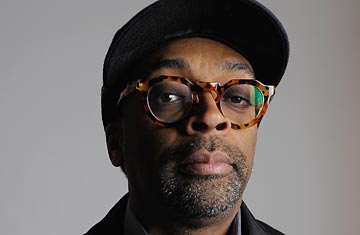
Spike Lee, director of the new ESPN documentary Kobe Doin' Work
Tune in to watch a New York Knicks basketball game and you may see Spike Lee trash-talking opposing stars from his courtside seats. Next to filmmaking, basketball is one of the director's greatest loves, and with his focus increasingly shifting toward nonfiction features (When the Levees Broke, Passing Strange), it was only a matter of time before Lee got around to shooting some hoops. (See pictures of Star Trek's best villains.)
Kobe Doin' Work is his documentary about Los Angeles Lakers star Kobe Bryant that is set to air on ESPN at 8 p.m. E.T. on May 16. Billed as a "game in the life" of one of the NBA's best players, Kobe Doin' Work could just as easily have been titled Kobe on Kobe, as Lee brought the guard into the studio to record his own commentary track. (See TIME's photo-essay "Magic Johnson: A Life in Sports.")
For the documentary, filmed during a 2008 playoff game between the Lakers and the San Antonio Spurs, Lee used more than two dozen cameras and a microphone Velcroed to Bryant's jersey to capture the action on the court. Behind the scenes, viewers also see Bryant's tranquil pregame routine and his interactions with head coach Phil Jackson during a halftime chalk talk. TIME spoke with Lee a week after the documentary's world premiere at the Tribeca Film Festival:
How did this project come to be? Why basketball and why Kobe?
I had seen a soccer film on the great [Zinedine] Zidane [Zidane: A 21st Century Portrait], and in that film they had numerous cameras following him. I saw it and thought, This is good — this might work well for basketball too. It was obvious that Kobe was going to win the MVP last year, and it was obvious that the Lakers would make the NBA Finals, so I gave the soccer film to Kobe, and he said, "Let's do it!"
After going through all your footage and watching this game from so many angles, do you watch basketball differently now?
Well, I've always done that. From my seats at [Madison Square] Garden, I'm always looking at what's happening on the bench and the interplay between the coach and the players — especially when a coach takes a player out. I'm looking at the player's reaction at being pulled from the game. (Watch TIME's video "A Free Lesson With: Kobe Bryant.")
When Kobe talks about the decisions being made on the court, you really bring to life the notion of a game as a chess match.
Kobe was very professorial in breaking down the game. His commentary is one of the main components of this film. You do a lot of that as a director on a DVD — recording commentary — and I knew I wanted him to do this from the very beginning. When he finally had time to do it, it was right after the game where he had scored 61 points against the Knicks this year. So he was in a pretty good mood.
Were you surprised by anything that you saw in the editing booth that maybe you didn't catch during the game?
He is a true leader. I think I knew this already, but it was really validated as you watched the team. These guys look up to him, and it's genuine. A lot of times, you might have a guy who scores the most points but who isn't the spiritual leader of the team. Kobe is, and you see it here time after time.
Most of this feels as though it's in real time. You stick with the tempo of the game and let the action do the talking.
That's the great thing about sports. It's not scripted. But I'll tell you, I had a sleepless night the day before precisely because it's not scripted. What if Kobe got into early foul trouble or was thrown out of the game? That would have been disastrous. (See the 100 best movies of all time.)
I was amazed at the serenity of the locker room during halftime.
Yeah, I had never been in that situation, but I knew it had to be a piece of the film. As a fan, I've always wanted to be a fly on the wall and hear the coach talk to the team as they make adjustments and look at video. Phil Jackson wasn't miked, but it was fascinating to watch the interplay between the superstar of the team and the coach. If you're a coach, you need to have a key player buy into your system. You need to have trust, and here's Kobe, performing the same duties that Michael [Jordan] did in Chicago.
The New York Post reported that Kobe demanded creative control over the project. Did he have to approve the commentary?
All of that stuff is a New York Post fabrication, and that's all I'll say about it. There's nothing but love between Kobe and I — there's nothing [to the Post report].
Did Kobe comment on things in the game that you hadn't seen, in all your editing?
There were a couple times in the game where he was open but deferred and gave the ball up to Derek Fisher or Sasha Vujacic — guys establishing themselves. I was surprised when, during his commentary, he said, "If the game gets tight, I'll still have that shot in the fourth quarter, so no need to show my hand this early."
I can just imagine all those people at home watching TV and yelling, "Kobe, why didn't you take that shot?!" But he made that decision very consciously.
[Laughs] That's why they're at home watching TV and Kobe is the MVP of the league!
